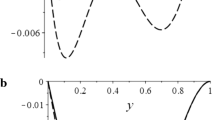Abstract
This paper uses a 4 × 4 expansion of the Hawk–Dove Game to illustrate how sexual drift in a large genotype space can shift a population from one equilibrium in a smaller phenotype space to another. An equilibrium is only safe from being destabilized in this way when implemented by recessive alleles.











Similar content being viewed by others
Notes
This metaphor may perhaps help to explain some of the data offered in support of theories of punctuated equilibrium.
On the understanding that the direction of increasing fitness is up rather than down, as in the diagrams of this paper.
For example, one needs to assume that each fish encounters every other fish in each period, and that the probability of survival depends only on the payoff in the current period.
References
Axelrod R, Hamilton W (1981) The evolution of cooperation. Science 211:1390–1396
Binmore K (1997) Rationality and backward induction. J Econ Methodol 4:23–41
Binmore K, Gale J, Samuelson L (1995) Learning to be imperfect: the Ultimatum Game. Games Econ Behav 8:56–90
Binmore K, Samuelson L (1997) Muddling through: noisy equilibrium selection. J Econ Theory 74:235–265
Binmore K, Samuelson L (1999) Equilibrium selection and evolutionary drift. Rev Econ Stud 66:363–394
Binmore K, Samuelson L (2011) Sex and evolutionary stability. J Theor Biol 278:63–73
Burger R (2000) The mathematical theory of selection, recombination and mutation. Wiley, Chichester
Foster D, Young P (1990) Stochastic evolutionary game dynamics. J Theor Biol 38:219–232
Gavrilets S (2004) Fitness landscapes and the origin of species. Princeton University Press, Princeton
Gavrilets S, Gravner J (1997) Percolation on the fitness hypercube and the evolution of reproductive isolation. J Theor Biol 184:51–64
Grafen A (1984) Natural selection, kin selection and group selection. In: Krebs J, Davies N (eds) Behavioural ecology, 2nd edn. Blackwell, Oxford
Hamilton W, Axelrod A, Tanese R (1990) Sexual reproduction as an adaptation to resist parasites. Proc Natl Acad Sci 87:3566–3573
Hofbauer J (1985) The selection mutation equation. J Math Biol 23:41–53
Kondrashov A (1988) Deleterious mutations and the evolution of sexual reproduction. Nature 351:435–440
Maynard Smith J (1982) Evolution and the theory of games. Cambridge University Press, Cambridge
Nowak M (2000) Evolutionary biology of language. Philos Trans R S Ser B 355:1615–1622
Otto S (2009) The evolutionary enigma of sex. Am Nat 178:S1–S14
Ponti G (2000) Cycles of learning in the Centipede Game. Games Econ Behav 30:115–141
Traulsen A, Hauert C, De Silva H, Nowak M, Sigmund K (2008) Exploration dynamics in evolutionary games. Proc Natl Acad Sci 106:709–712
Weissman D, Desai M, Fisher D, Feldman M (2009) The rate at which asexual populations cross fitness valleys. Theor Popul Biol 10:10–16
Wright S (1982) The shifting balance theory and macroevolution. Ann Rev Genet 16:1–19
Zeeman C (1981) Dynamics of the evolution of animal conflicts. J Theor Biol 89:249–270
Author information
Authors and Affiliations
Corresponding author
Rights and permissions
About this article
Cite this article
Binmore, K. Sexual Drift. Biol Theory 8, 201–208 (2013). https://doi.org/10.1007/s13752-013-0103-5
Received:
Accepted:
Published:
Issue Date:
DOI: https://doi.org/10.1007/s13752-013-0103-5




